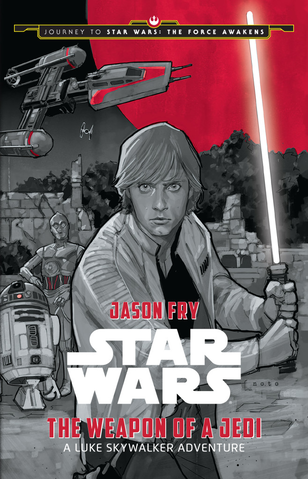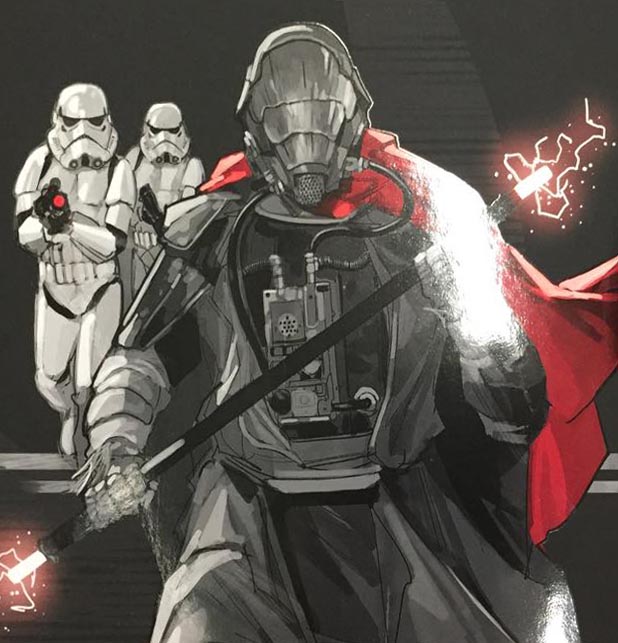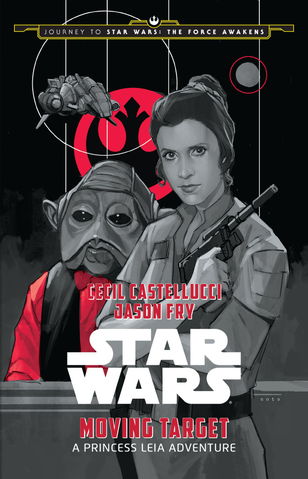 Jason Fry, author of more than thirty books in the Star Wars franchise, has already been gracious enough to grant us biannual interviews since Eleven-ThirtyEight’s inception; but this time was a challenge all around—not only did I have to cover his two different Force Friday releases, The Weapon of a Jedi and Moving Target, last Tuesday’s Servants of the Empire finale The Secret Academy, the upcoming third book in his Jupiter Pirates series, and any potential future projects in fewer than a hundred questions, but Jason himself was double-booked this past weekend (with appearances within a couple hours of each other at both New York Comic-Con and Star Wars Reads Day in the Maplewood Memorial Library in New Jersey). Luckily, we pulled it off—I assume it’s because he’s extra-pumped about the Mets being in the playoffs. Below we’ll discuss his Luke and Leia books; stay tuned for the latest on Zare Leonis, and more, on Wednesday.
Jason Fry, author of more than thirty books in the Star Wars franchise, has already been gracious enough to grant us biannual interviews since Eleven-ThirtyEight’s inception; but this time was a challenge all around—not only did I have to cover his two different Force Friday releases, The Weapon of a Jedi and Moving Target, last Tuesday’s Servants of the Empire finale The Secret Academy, the upcoming third book in his Jupiter Pirates series, and any potential future projects in fewer than a hundred questions, but Jason himself was double-booked this past weekend (with appearances within a couple hours of each other at both New York Comic-Con and Star Wars Reads Day in the Maplewood Memorial Library in New Jersey). Luckily, we pulled it off—I assume it’s because he’s extra-pumped about the Mets being in the playoffs. Below we’ll discuss his Luke and Leia books; stay tuned for the latest on Zare Leonis, and more, on Wednesday.
Might as well get the Force Awakens business out of the way. I’m always very interested in the mechanics of how they tease things from an upcoming film, and my original question was going to be how you ended up using Sarco Plank specifically in The Weapon of a Jedi. Then I read your recent piece on the Official Site, and you say that by the time you came aboard, not just Plank’s role but the general outline of the story was already in place. Is that typical in a situation like this, to be handed not just a character but a rough plot? The TFA elements of Moving Target, on the other hand, remain a little more mysterious; how much of that book was decided before you and Cecil Castellucci became involved?
Every project is different, but I knew from the beginning that Weapon of a Jedi, as part of Journey to The Force Awakens, would be really different. For Weapon of a Jedi the basic plot was set, so I focused on figuring out Luke’s character and his arc – the book flies or dies based on how drawn in you are by Luke’s Force training and what he learns about the Force and himself. Contrast that assignment with, say, Servants of the Empire – for those books I had one episode to incorporate, a cameo to feature, and some story threads to include, but otherwise I had a free hand with the plots and characters.
Still, even with a set plot there’s a fair amount of leeway for an author, which means lots of fun to be had. The original plot of Weapon of a Jedi imagined far more cat-and-mouse between Luke, Sarco and the stormtroopers in the temple, but I advocated – correctly, I think – for dialing that back because I thought a simpler story fit the fairy-tale quality of what was developing in my head. That refining goes in both directions, though – my original idea for the book’s beginning had Luke fighting his way out of a compromised meeting on Giju, but Michael Siglain thought that starting with a space battle would be a lot better for grabbing readers. He was absolutely right – that choice also let me zero in on the conflict Luke feels between being an Alliance hero and a starpilot and his responsibilities to his Jedi heritage, which brought Luke into focus better and earlier.
 An interesting thing about Sarco – I originally wrote a placeholder character for him, because I knew access to the art/descriptions would come at a later stage in the process. I tried leaving that character essentially as a “blank” in the narrative but found I couldn’t do it – it messed up the interplay between Sarco, Luke and the droids, which was really important. So I shrugged and wrote him as an old, scarred Devaronian outcast. I knew that was going to change, but still felt a little sad when I got art reference and had to switch out the old Sarco for the new. It’s funny how attached we can get to characters.
An interesting thing about Sarco – I originally wrote a placeholder character for him, because I knew access to the art/descriptions would come at a later stage in the process. I tried leaving that character essentially as a “blank” in the narrative but found I couldn’t do it – it messed up the interplay between Sarco, Luke and the droids, which was really important. So I shrugged and wrote him as an old, scarred Devaronian outcast. I knew that was going to change, but still felt a little sad when I got art reference and had to switch out the old Sarco for the new. It’s funny how attached we can get to characters.
Something similar happened with the mounts Luke and Sarco use – I won’t say more, but those who have been keeping up with rumors will figure it out easily enough. There, once again, I was a little bummed to sub out the cool creature I’d thought of even though I’d known that was going to happen. Fortunately, in that case I found myself needing mounts for some scenes in The Secret Academy. So that beastie got resurrected!
On the subject of Moving Target, this is the first time I’m aware of that you’ve co-written a story like this—as opposed to the Essential Guides, which are effectively collections of essays that don’t require as much of a consistent authorial voice. Did it work differently this time, or did you find the collaborative process basically the same?
Collaborations in fiction are interesting, and often pretty personal for writers. I apologize for a wussy answer, but I generally feel like the mechanics of such collaborations are best left as internal matters. It feels a bit like asking a magician (or, in this case, magicians) to explain a trick. We used the Force, y’know? Well, the Force and the vast storytelling powers of Lucasfilm and Disney.
We’ve spoken a lot, both in these interviews and elsewhere, about how exactly inter-book continuity is being handled now in the Story Group era, and there’s an interesting dichotomy present in your two Big Three books. In Weapon, you deal with one of the most popular subjects in the new canon, Luke’s early post-Yavin Jedi training. Yet despite this having been addressed in both the earlier novel Heir to the Jedi and Jason Aaron’s Star Wars comics, there’s been a very impressive consistency in terms of what Luke does and doesn’t know, the order in which he learns things, whether Ben is still talking to him, etc.
 On the other hand, Target features one of the first real contradictions; the story ends with Leia’s team stealing the shuttle Tydirium, despite Ultimate Star Wars having established a few months back that Wedge stole it. While a prose novel contradicting one sentence in an early reference book is not a big deal to me personally, the fact is I see people grumbling about this stuff at least as often as they praise things like Luke’s training. Now that we have a couple concrete examples to point to, I’m hoping you can talk a bit about how each of these sort of best- and worst-case scenarios are coming about—fanboys are gonna fanboy, but I think at the very least it’s important that both blame and credit are going in the right directions.
On the other hand, Target features one of the first real contradictions; the story ends with Leia’s team stealing the shuttle Tydirium, despite Ultimate Star Wars having established a few months back that Wedge stole it. While a prose novel contradicting one sentence in an early reference book is not a big deal to me personally, the fact is I see people grumbling about this stuff at least as often as they praise things like Luke’s training. Now that we have a couple concrete examples to point to, I’m hoping you can talk a bit about how each of these sort of best- and worst-case scenarios are coming about—fanboys are gonna fanboy, but I think at the very least it’s important that both blame and credit are going in the right directions.
To put it more simply, when something works out really well, like in Luke’s case, how much of that is the editorial/SG process, and how much of that is you just being good at this yourself? Is it still safe to say that the overall process is better at catching errors now than it was five years ago?
I can’t answer the question about how the process is working for catching errors, because I haven’t kept track. Also, I think it’s important to remember that this is a new process for Lucasfilm and Disney as well as all of us who are observing it. I’m sure it will keep evolving.
I didn’t notice the Tydirium thing until after Moving Target was out of our hands. As for the smooth flow between Heir to the Jedi, Weapon of a Jedi and the Marvels, the credit goes entirely to Lucasfilm and Disney. If memory serves I didn’t read Heir until after I completed my work on Weapon of a Jedi, and I’m ashamed to say I haven’t read the Marvels yet.
That working in isolation was a new experience for me, as I’m used to projects that are heavy on continuity and often do a fair amount of the heavy lifting myself. This time I had a story and I just ran with it, leaving the larger coordination to Lucasfilm and Disney. I’ll confess I was a bit nervous about that, but I actually found it really freeing – I could just let the story rip and rely on those folks to nudge me towards A and away from B. (Of course I did my usual geeking out with secondary characters and geography and what-not.)
One thing I think is important to note is that right now we’re only seeing “backwards” coordination – links between various eras, or between stories emerging simultaneously. But I get the feeling that will change. An interesting development is now I’ll get notes from Lucasfilm and Disney suggesting a mention of X, or an emphasis on Y, with an eye on the storytelling future, and not the past or some concurrent project. In some cases I’ve understood where that’s going and have been an eager participant, while in other cases I’m in the dark and following their lead.
I expect that over the coming months and years we’ll start seeing the results of that “forwards” coordination, and not just in terms of puzzle pieces such as the ones in the Journey project. (Though those were a lot of fun.) I find that really exciting both as a writer and as a fan. I get the feeling that all sorts of cool seeds are being planted and can’t wait to see what comes up out of the ground.
Okay, that last question was a beast, so I’ll finish with something simpler. One of the great pleasures in the Journey books was Moving Target addressing Leia’s reaction to the news of a second Death Star, something I don’t believe the EU ever got around to. She makes some hard decisions in this story in order to carry out her mission, even potentially painting the Alliance in a bad light—all in service of the eventual Battle of Endor. Do you think these kind of rough edges are typical of Leia, or is the Death Star bringing something uncharacteristic out of her? Seeing her go by “General Organa” in the prologue was a big deal to a lot of fans—for a variety of reasons, but partly because it’s a military role, not a diplomatic one. Can Moving Target be seen as her beginning to step away from the figurehead role of “Princess Leia” for good?
 That’s a great question re Leia and her figurehead role. I don’t claim to know the answer, in part because of what I discussed above in terms of forwards coordination. But I agree about Leia and the second Death Star. The Death Star’s an existential threat to everyone, of course – things that can blow up planets generally are – but to Leia it’s actually even bigger than that. It’s the end of the Senate, her parents, her planet and her cause. It’s the antithesis of everything she’s aligned herself with – limitless credits and brutal technology, all designed to extinguish life and liberty. She loses so much in seeing this thing destroyed at Yavin … and then there’s another one? It’s kind of amazing that the EU never zeroed in on that as a character moment, isn’t it? (Now I’m worried something did and I’ve forgotten.)
That’s a great question re Leia and her figurehead role. I don’t claim to know the answer, in part because of what I discussed above in terms of forwards coordination. But I agree about Leia and the second Death Star. The Death Star’s an existential threat to everyone, of course – things that can blow up planets generally are – but to Leia it’s actually even bigger than that. It’s the end of the Senate, her parents, her planet and her cause. It’s the antithesis of everything she’s aligned herself with – limitless credits and brutal technology, all designed to extinguish life and liberty. She loses so much in seeing this thing destroyed at Yavin … and then there’s another one? It’s kind of amazing that the EU never zeroed in on that as a character moment, isn’t it? (Now I’m worried something did and I’ve forgotten.)
More generally, a key aspect of Moving Target was exploring Leia’s formidable sense of duty and how that conflicts with her (understandably) walled-off sense of herself. The classic-era story tackles that from the very beginning, but in a way that I hope gives Leia an emotional arc that’s satisfying and believable, leaving the reader to think she’s confronted some of those questions and discovered a way to balance them. Or at least she’s found a way to start finding out how to do that, despite the unimaginable pressure she faces. And then, from there, the hope is that the bookends give you something to wonder about as we wait to see Leia again, decades later.
That’s it for today; come back on Wednesday for more with Jason, including his thoughts on the just-released Servants of the Empire: The Secret Academy, and an update on his own young-adult series The Jupiter Pirates!

2 thoughts to “Our Journey With Jason Fry, Part One”
Comments are closed.